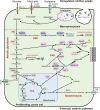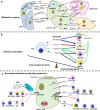Cancer metabolism and intervention therapy
- PMID: 35006438
- PMCID: PMC8607959
- DOI: 10.1186/s43556-020-00012-1
Cancer metabolism and intervention therapy
Abstract
Metabolic reprogramming with heterogeneity is a hallmark of cancer and is at the basis of malignant behaviors. It supports the proliferation and metastasis of tumor cells according to the low nutrition and hypoxic microenvironment. Tumor cells frantically grab energy sources (such as glucose, fatty acids, and glutamine) from different pathways to produce a variety of biomass to meet their material needs via enhanced synthetic pathways, including aerobic glycolysis, glutaminolysis, fatty acid synthesis (FAS), and pentose phosphate pathway (PPP). To survive from stress conditions (e.g., metastasis, irradiation, or chemotherapy), tumor cells have to reprogram their metabolism from biomass production towards the generation of abundant adenosine triphosphate (ATP) and antioxidants. In addition, cancer cells remodel the microenvironment through metabolites, promoting an immunosuppressive microenvironment. Herein, we discuss how the metabolism is reprogrammed in cancer cells and how the tumor microenvironment is educated via the metabolic products. We also highlight potential metabolic targets for cancer therapies.
Keywords: Cancer; Heterogeneity; Metabolic reprogramming; Targeted therapy; Tumor microenvironment.
© 2021. The Author(s).
Conflict of interest statement
The authors have declared that no competing interest exists.
Figures




Similar articles
-
Glucose Metabolism and Tumor Microenvironment: Mechanistic Insights and Therapeutic Implications.Int J Mol Sci. 2025 Feb 22;26(5):1879. doi: 10.3390/ijms26051879. Int J Mol Sci. 2025. PMID: 40076506 Free PMC article. Review.
-
MicroRNAs as Regulators of Cancer Cell Energy Metabolism.J Pers Med. 2022 Aug 18;12(8):1329. doi: 10.3390/jpm12081329. J Pers Med. 2022. PMID: 36013278 Free PMC article. Review.
-
Enhanced metabolic activities for ATP production and elevated metabolic flux via pentose phosphate pathway contribute for better CIK cells expansion.Cell Prolif. 2019 May;52(3):e12594. doi: 10.1111/cpr.12594. Epub 2019 Mar 7. Cell Prolif. 2019. PMID: 30847992 Free PMC article.
-
Acidosis induces reprogramming of cellular metabolism to mitigate oxidative stress.Cancer Metab. 2013 Dec 23;1(1):23. doi: 10.1186/2049-3002-1-23. Cancer Metab. 2013. PMID: 24359630 Free PMC article.
-
Metabolic reprogramming for producing energy and reducing power in fumarate hydratase null cells from hereditary leiomyomatosis renal cell carcinoma.PLoS One. 2013 Aug 15;8(8):e72179. doi: 10.1371/journal.pone.0072179. eCollection 2013. PLoS One. 2013. PMID: 23967283 Free PMC article.
Cited by
-
Altered metabolism in cancer: insights into energy pathways and therapeutic targets.Mol Cancer. 2024 Sep 18;23(1):203. doi: 10.1186/s12943-024-02119-3. Mol Cancer. 2024. PMID: 39294640 Free PMC article. Review.
-
Cancer Cell Metabolism Reprogramming and Its Potential Implications on Therapy in Squamous Cell Carcinoma of the Head and Neck: A Review.Cancers (Basel). 2022 Jul 22;14(15):3560. doi: 10.3390/cancers14153560. Cancers (Basel). 2022. PMID: 35892820 Free PMC article. Review.
-
Novel therapeutic agents in clinical trials: emerging approaches in cancer therapy.Discov Oncol. 2024 Aug 11;15(1):342. doi: 10.1007/s12672-024-01195-7. Discov Oncol. 2024. PMID: 39127974 Free PMC article. Review.
-
Simultaneous suppression of PKM2 and PHGDH elicits synergistic anti-cancer effect in NSCLC.Front Pharmacol. 2023 May 22;14:1200538. doi: 10.3389/fphar.2023.1200538. eCollection 2023. Front Pharmacol. 2023. PMID: 37284309 Free PMC article.
-
Nanomedicines Targeting Metabolic Pathways in the Tumor Microenvironment: Future Perspectives and the Role of AI.Metabolites. 2025 Mar 13;15(3):201. doi: 10.3390/metabo15030201. Metabolites. 2025. PMID: 40137165 Free PMC article. Review.
References
Publication types
Grants and funding
LinkOut - more resources
Full Text Sources
Research Materials
Miscellaneous
